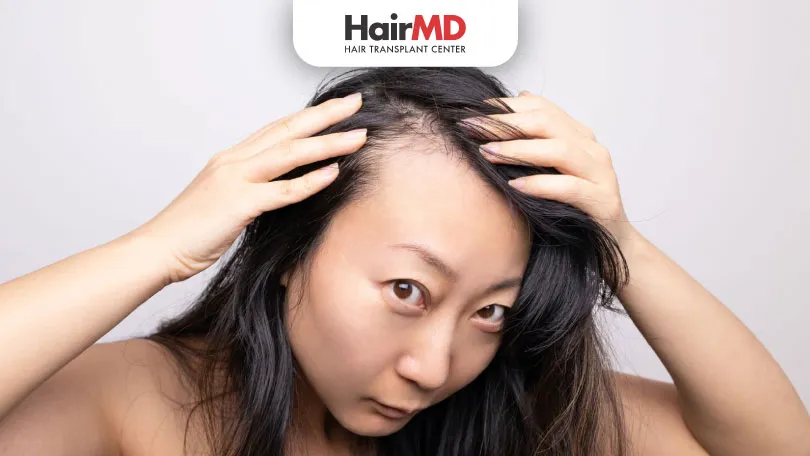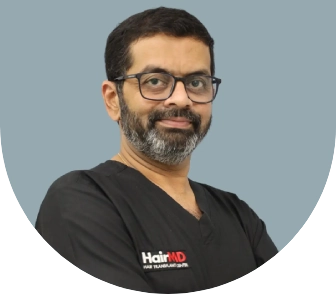5th Jan, 2023

One of the commonest problems faced by both men and women alike is hair loss. The age and pattern of hair loss vary for different individuals; for some, it may begin during their teens, and for some, it may occur in their late 30s.
If you search for hair thinning at temples females, you’ll be amazed at how prevalent the problem is. A study conducted on hair loss reported that nearly 40% of women by the age of 50 suffer from hair thinning. In a study conducted in Australia, reports suggested that 98.6% of men over the age of 20 had a bitemporal recession and forehead baldness.
What’s covered in the article?
- What is Meant by Hair Loss on Temples?
- What are the Symptoms of Hair Loss on the Temples?
- What can be the Causes?
- How to Prevent Hair Loss on the Temples?
- Take Action Now
- Temple Hair Loss Treatment
- Why choose HairMD?
- Conclusion
What is Meant by Hair Loss on Temples?
When hair starts thinning at the temples, it is known as temple hair loss. It occurs on the side of the head, between the ears and eyes. The scalp becomes visible, and hair starts thinning on the sides; sometimes, it spreads to the crown area. Expert studies indicate that hair loss can be predominant on one side of the head for some patients; it is also known as side hair loss. There are many reasons for hair loss, and the most common are androgenetic alopecia, telogen effluvium, hormonal imbalance, and vitamin deficiency. Temporal hair loss in males may be an early sign of androgenetic alopecia, and in females may be a sign of aging.
What are the Symptoms of Hair Loss on the Temples?
Normally a person loses between 50-100 strands of hair every day. When you start losing more than 100 strands a day, it is a sign of hair health trouble every day. You may start noticing a gradual decrease in the hairline, forehead hair loss, balding temples, hair starts thinning, and the scalp becomes visible. These are some of the early indications of hair loss, which, if untreated, will cause early balding. It is, therefore, essential to observe your hair fall pattern and keep an eye on the hairline. Early detection and the right intervention can help reverse hair loss.
How To Use Hair Oil And Minoxidil Without Hampering Its Action | HairMD, Pune
What can be the Causes?
Hair growth has a complete cycle of growth, loss, and regrowth, wherein every hair strand is lost and replaced at regular intervals. Hair follicles have cyclical phases of growth, involution, quiescence, and regeneration. The anagen or growth phase is known to have a lifespan of about 3-5 years; it is followed by involution, which lasts for a few weeks and ends with a quiescence phase that lasts for approximately 3 months. 1 cm per month, is the rate at which hair grows. Hair loss happens when this cycle gets disturbed, and the regrowth gets affected, leading to hair thinning and slow regrowth.
We’ve listed down some of the known causes of hair loss below.
Androgenetic alopecia is a genetic problem that causes balding in 80% of hair fall cases. Both males and females are affected by it. When you search for what causes female hair loss in temples or hair loss at temples male, you’re likely to get this result.
Telogen effluvium type of hair loss is observed around the temples, and hair tends to thin at the head’s crown. This type of hair loss happens because of hormonal imbalance, fever, nutritional deficiency, and childbirth.
PCOS/PCOD or Polycystic Ovary Syndrome, wherein cysts develop in the ovaries, causes an imbalance in female reproductive hormones. PCOS affects young women and can cause hair thinning around the temples and lead to female pattern hair loss.
If you have noticed unusual side baldness and visible signs of hair thinning at temples or a receding hairline, you must keep track of it. Early intervention can help in correcting and reducing hair loss.
How to Prevent Hair Loss on the Temples?
If hair loss is due to genetics, it cannot be fully prevented, but there are some ways to reduce the problem and understand how to grow hair on the forehead.
- Reduce stress: Stress is known to cause many health problems; it is advisable to identify stress triggers and reduce them. Activities that help you calm down will go a long way in arresting hair loss and increasing forehead hair growth.
- Eat healthily: What you eat is what you become. Try to incorporate healthy fat, leafy greens, and proteins from legumes, meat, etc., to have a healthy shiny mane and temple hair regrowth.
- Exercise every day: Move your body for at least half an hour a day. Exercise helps transport oxygen to all the parts of your body. A well-oxygenated scalp will have more blood flow, which means reduced hair fall.
- Avoid tight hairstyles: Tight ponytails may look stylish and fashionable, but they are a leading cause of receding hairline and irritated scalp. Wear your hair loose and relaxed, and it’ll help reduce hair breakage.
- Avoid harsh products: Hot curling irons, hair straighteners, heavy styling products, etc., are leading causes of hair loss. Switch to mild and chemical-free products and observe a difference in your hair loss.
- Warm oil massage: Not enough can be said about the joys of warm coconut or olive oil head massage. Try to incorporate head massage at least once a week. Keep it on for half an hour and wash it off with a mild shampoo in lukewarm or cold water. The oils are full of nutrition, which will protect your hair shaft and penetrate deep into the scalp to make hair stronger from the root. Care should be taken to do it gently and use fingertips to massage.
- Minoxidil solution: Often, when you search for how to regrow hair on the forehead or how to grow forehead hair, or how to grow hairline on the forehead, you’ll spot minoxidil. It is a popular medication generally prescribed to stimulate hair growth for both men and women. The topical solution is applied to the scalp once or twice daily to encourage new hair growth. It has proven to be quite effective, but the results vary from individual to individual. However, minoxidil is not free from side effects; women have frequently reported scalp irritation, dizziness, unwanted hair growth, etc. It is advised to use minoxidil under proper guidance from a Doctor.
Does Minoxidil Work On Receding Hairline | HairMD, Pune
Take Action Now
Male pattern baldness and female pattern baldness are not fully reversible, and we understand that it causes quite an emotional strain on affected individuals. However, help is at hand; there have been significant breakthroughs in hair loss treatments with the intervention of new medicines and hair transplant surgeries.
Temple Hair Loss Treatment
Temple hair loss is common in females and males and may have a number of reasons which include, hormonal changes, nutritional deficiencies, stress, smoking, and wearing tight hairstyles. Hair loss near the temples may also occur as a side effect of certain medicines. Male or female hair loss at the temples is a sign of male pattern baldness as also a symptom of female pattern baldness and can be treated effectively if medical intervention is sought as soon as hair loss around the temples is observed.
The most effective temple hair loss treatments include topical medicines like finasteride and minoxidil, which are FDA-approved, hair transplantation, PRP, nano fat, and low-level laser therapy also are supportive treatments. If hair loss near and around the temples is caused by a certain deficiency, increasing the intake of that nutrient helps treat the condition. If hormonal fluctuations are causing temple hair loss, restoring hormonal balance helps restore hair growth. One should avoid hairstyles that pull or strain the hair and treatments that expose the hair to heat and chemicals. Along with the treatment advised by a medical expert, stress management, a healthy diet, and lifestyle, and a proper hair care routine are also important in preventing further hair loss, promoting hair growth, and maintaining a healthy scalp and beautiful hair. For proper consultation and treatment of your hair condition, it is necessary to visit your dermatologist.
Modern and effective solutions like FUE Hair Transplant, Female Hair Loss Treatment, Male Hair Loss Treatment, and Alopecia Areata treatment have helped thousands of patients to regain their crowning glory. Depending on the type of hair loss that is identified by experts, you can avail of the treatment. One must visit a reputed and certified clinic that specializes in identifying the hair loss pattern and provides a suitable treatment. HairMD is one such clinic based in Pune, which has a specialized team of Dermatologists, Trichologists, and Surgeons with years of experience in successfully treating hair loss for nearly three decades.
Why choose HairMD?
HairMD has been a go-to place for individuals suffering from hair loss problems for nearly three decades. HairMD has collectively treated more than 50,000 patients, and done hair transplants on more than 702 patients, and counting. With branches all over Pune, HairMD has been ahead of time by upgrading each of its clinics with state-of-the-art equipment and helping its staff stay up to date with new technology and treatment lines.
Book an appointment with HairMD today for your hair loss concerns!
Do You Know?
Nearly 250 Patients Visit HairMD
Everyday For Various Hair Concerns?
(Your journey to healthier and fuller hair starts here!)
Meet Our Dermatologists
Conclusion
To effectively tackle temple hair loss, early intervention is crucial. While genetic factors are beyond control, preventive measures like stress management, a balanced diet, and avoiding harsh treatments can help. Professional treatments such as medication, PRP, and hair transplants offer promising results. Consulting a Hair specialist in Pune, can provide tailored solutions for reclaiming healthy hair.
Further Reading
What Causes Hair Loss?
Discover common causes of hair loss like stress, hormones, diet, and poor hair care, plus expert tips on prevention and treatment.
Can You Get a Hair Transplant Without Shaving Your Head?
Hair transplant without shaving offers a discreet option for restoring hair. This method suits mild hair loss and allows you to maintain your natural look.
Manual Vs Robotic Hair Restoration
Discover the pros and cons of manual vs robotic hair restoration. Learn why manual hair transplants deliver natural results. Consult a hair specialist in Pune today.
Can Rainwater Cause Hair Loss? Understanding the Impact
Find out if Rainwater Cause Hair Loss & how to keep your hair safe during the monsoon season. Expert tips for keeping your hair healthy in rainy weather!
Have thoughts? Please let us know
We are committed not only to treating you, but also educating you.










